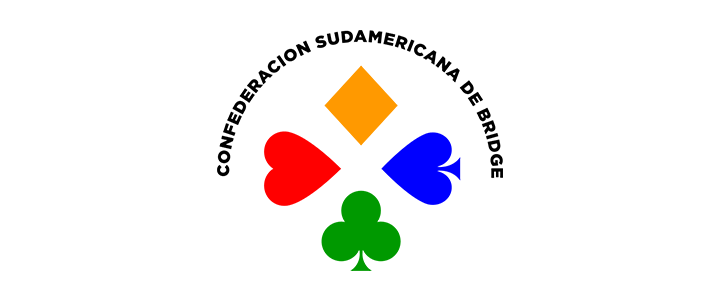Source: Washington Bridge League Solver’s Club
|
Imps |
Vul: None |
|
South Holds
|
|
|||||||||||||

It makes sense to me, and five experts agree, that this hand should be played in game. But which game? 4![]() ? 3NT? Even 4
? 3NT? Even 4![]() could be right if partner has at least five hearts. So how do you make sure that you get to the best game? Make a flexible bid. I suggest that you invent a jump shift into clubs, the lowest suit, and allow partner to describe his hand. If partner bids 3
could be right if partner has at least five hearts. So how do you make sure that you get to the best game? Make a flexible bid. I suggest that you invent a jump shift into clubs, the lowest suit, and allow partner to describe his hand. If partner bids 3![]() or 3
or 3![]() , you raise to four. If partner bids 3NT you have a decision to make. You can either pass 3NT or correct to 4
, you raise to four. If partner bids 3NT you have a decision to make. You can either pass 3NT or correct to 4![]() . You should take into account that partner will bid 3NT with the red suits well stopped. If partner raises clubs, you can always go back to spades. Since a jump to
. You should take into account that partner will bid 3NT with the red suits well stopped. If partner raises clubs, you can always go back to spades. Since a jump to ![]() can be made on a short suit, partner is barred from insisting on playing in clubs.
can be made on a short suit, partner is barred from insisting on playing in clubs.
One expert agrees with me.
Schwartz: «3![]() —Have to force to game, but can’t bid a game outright(3NT,4
—Have to force to game, but can’t bid a game outright(3NT,4![]() ) since game is quite likely elsewhere(even 4
) since game is quite likely elsewhere(even 4![]() is possible). 3
is possible). 3![]() leaves the most space and if partner raises, have an easy 4
leaves the most space and if partner raises, have an easy 4![]() bid. In standard 3
bid. In standard 3![]() can be short.»
can be short.»
Four experts jump to 4![]() . The trouble with 4
. The trouble with 4![]() is that it puts all your eggs in one basket. Partner could have seven hearts and zero spades.
is that it puts all your eggs in one basket. Partner could have seven hearts and zero spades.
Kerns:»4![]() —With a prayer. Perhaps he has five HCPs.
—With a prayer. Perhaps he has five HCPs. ![]() Qx
Qx![]() Qxx
Qxx![]() JT9x
JT9x![]() xxxx and I would be no worse off than 50% on my game. I might make game opposite this four-HCP hand xx/xxx/xxxx/Axxx, with spade Qx on-side. 4
xxxx and I would be no worse off than 50% on my game. I might make game opposite this four-HCP hand xx/xxx/xxxx/Axxx, with spade Qx on-side. 4 tells him I want game opposite any decent six HCPs. He could have one spade and more HCPs also. Hand also plays better with lead coming to me as opposed to notrump.»
tells him I want game opposite any decent six HCPs. He could have one spade and more HCPs also. Hand also plays better with lead coming to me as opposed to notrump.»
Woolsey: «4![]() —A bit too much playing strength to bid only 3
—A bit too much playing strength to bid only 3![]() . We might belong in notrump but it is difficult to find out. I suppose I could try 3
. We might belong in notrump but it is difficult to find out. I suppose I could try 3![]() , planning on bidding 4
, planning on bidding 4![]() over 4
over 4![]() , but that is scary business.»
, but that is scary business.»
King: «4![]() —I want to be in game, so I must make a forcing bid or bid game. My hand is more oriented to a suit contract than notrump, but partner could have soft values making nine tricks our best shot. He also could have Qxxxx(x) of Hearts, making that the best strain, but I hate to jump to 3
—I want to be in game, so I must make a forcing bid or bid game. My hand is more oriented to a suit contract than notrump, but partner could have soft values making nine tricks our best shot. He also could have Qxxxx(x) of Hearts, making that the best strain, but I hate to jump to 3 and then guess over his rebid. I know some people who play 2NT as forcing in this sequence, allowing a better exploration without distorting one’s hand pattern so much. Without the nine of spades I would explore alternative contracts more.»
and then guess over his rebid. I know some people who play 2NT as forcing in this sequence, allowing a better exploration without distorting one’s hand pattern so much. Without the nine of spades I would explore alternative contracts more.»
If you’re not sure you want to be in 4![]() , why bid it?
, why bid it?
One expert raises to 2NT and one expert jumps to 3NT. Bidding notrump will cause you to miss your 6-2 spade fit. How well will notrump play if partner has three little in one of the minors?
Parker: «2NT—This allows us to find hearts if partner has five and bids over 2NT. Partner can bid a weak six-card minor or take a spade preference. Any other jump, 3NT or 3![]() , greatly reduces our options. I would like to bid 2
, greatly reduces our options. I would like to bid 2![]() forcing.»
forcing.»
2![]() is not forcing but 3
is not forcing but 3![]() is.
is.
Hopkins:»3NT—Very close. 2NT and 3![]() are underbids. Both 4
are underbids. Both 4![]() and 3NT are reasonable. I bid 3NT because it needs fewer tricks.»
and 3NT are reasonable. I bid 3NT because it needs fewer tricks.»
If you have to set up the spade suit in order to make 3NT, the opponents could very easily take five tricks first.
The following bid is dangerous. If partner raises to 4![]() , do you pass and play a possible 4-3 fit or do you correct to 4
, do you pass and play a possible 4-3 fit or do you correct to 4![]() ?
?
Warren: «3![]() —To show 18 points. A jump to 3
—To show 18 points. A jump to 3![]() is not enough, 2NT doesn’t describe the hand, 3NT is a bit ambitious. Partner with seven HCPs or more will bid again.»
is not enough, 2NT doesn’t describe the hand, 3NT is a bit ambitious. Partner with seven HCPs or more will bid again.»
Only if I was desperate, would I ever bid a three-card major.
The following expert invites. Could be right but in this problem a minority opinion.
Cole: «3![]() —3
—3![]() won’t get you to the right game. 2NT loses the 6-2 fit. 3
won’t get you to the right game. 2NT loses the 6-2 fit. 3![]() loses 5-3 heart fit. With such prime values the first priority should be the 6-2 spade fit. It is right to bid 2NT if looking for a board to take a mild swing.»
loses 5-3 heart fit. With such prime values the first priority should be the 6-2 spade fit. It is right to bid 2NT if looking for a board to take a mild swing.»
3![]() allows you to get to 4
allows you to get to 4![]() when that is right and 4
when that is right and 4![]() when that is right. 3
when that is right. 3![]() also allows you to get to 3NT but only when you don’t belong in four-of-a-major.
also allows you to get to 3NT but only when you don’t belong in four-of-a-major.
